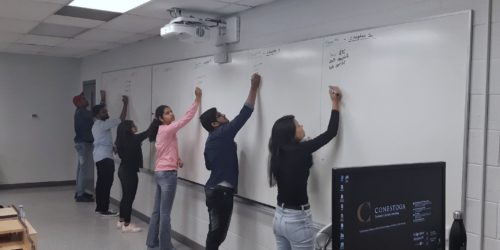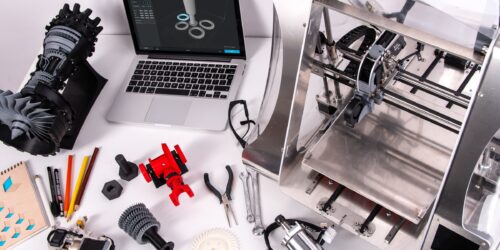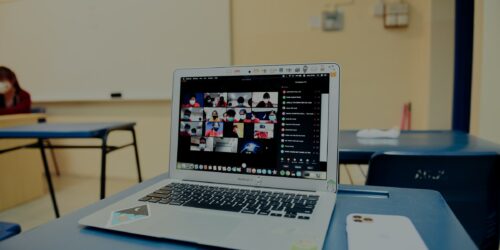
Teaching for Tomorrow: Evolving Practices for the 21st Century
Faculty guest post by Michael Quartermain, School of Business.
“Just because I taught it doesn’t mean they learned it.”
(Nelson, 2022)
Recently, this quote from the faculty development workshop “Teaching Theory to Practical Learners” by Nancy Nelson resonated with me because it made me wonder how my teaching translates into the student experience, which is vastly different from my own.
Context of a Full-Time Faculty Member
I have been teaching in the Strategic Global Business Management Post-Secondary Diploma Program for International Students, delivered exclusively to international students. This program teaches the theory and application of various concepts for Canadian and international business industry careers.
However, there is a high level of change for these students as they transition to a different higher education system. There are also substantial cultural and social changes for them that can get in the way of learning. This transition faced by international students can lead them to ask many questions, make hard decisions, and cope with balancing competing priorities which require a degree of motivation during a period of life with great expectations, not only for the students but also for their families.
And so, I come back to my opening quote. While I deliver meaningful content that students embrace, these students may need from me a way of teaching that is different from how I was taught throughout my education.
Engaging Professional Faculty Development for Improved Delivery
I took and am still taking various courses offered by Teaching and Learning. As I continue to teach my students, I realize the value of the EDEV micro-credential courses and Post Secondary Teaching Certificate offered by the College to help challenge and further develop my teaching self.
My focus during the Post-Secondary Teaching Certificate and my course selections were driven by my desire to develop my teaching self to provide an improved delivery in business education at a high level (versus any specific course) and how I could provide a relevant experience for students, considering the potential transition challenges faced by students. From a business perspective and my own experience, it is essential to facilitate the capacity building of students to be our future leaders.
Two personal learning outcomes that I looked to achieve were:
- Development of critical thinking through learner experiential and facilitated concepts.
- Reflection through observation to achieve deeper learning.
Two Models that Have Informed and Evolved My Teaching
The first model that informs my teaching is outcomes-based education. I view this evolution in my teaching practices from the deductive delivery of materials (traditional) to ensuring I consider the whole learner while emphasizing the development of the knowledge, skills, and competencies aligned with learning outcomes-based education across various delivery modes. As Figure 1 shows, learning outcomes are critical to my teaching role and to learners to understand the learning goals in their course and program.
Figure 1: How do learning outcomes fit into program goals?

The Triple Helix Transformative Teaching and Learning Model in Business Education is the second model I connected with as part of my evolving teaching practices. The Triple Helix Transformative Teaching and Learning Model is a framework for business education based on the idea that the context and learning environment must work together to provide students with hands-on experience and real-world knowledge. This approach to business education aims to create a more dynamic and adaptive learning environment and better prepare students for the challenges of the 21st century (Longmore et al., 2017).
The conceptual construct is three-dimensional and developed around three key spheres:
- The whole learner, including emotions, reflection, and action.
- The content and knowledge, readings, research, industry, and projects.
- Other Learning Actions, Business partners, learning facilitators, and other learnings.
The intersection of the three spheres provides a socially constructed experience for the learner. This model considers the dynamic nature of interpersonal (reflection) and intrapersonal (interaction) as part of a learning cycle (Longmore et al., 2017).
This approach is about co-creating new knowledge and understanding, which informs the planning and creation of assessments and lesson plans for a diverse student population (Longmore et al., 2017). Another way to state my view of this evolution in my teaching practices is moving from the deductive delivery of materials (traditional) to the idea of inductive learning (paradigm shift).
An Ongoing Journey of Learning
Three key learnings I have taken from the Teaching and Learning EDEV courses to date that I can consider in my business teaching practices include:
- The intercultural implications and challenges for students new to the Canadian assessment and teaching practices.
- How STEM learning can establish a welcoming learning environment for students while balancing the assessments with the rigor to deliver deeper learning as part of evolving practices.
- Reflecting on myself as a teacher around developing practices and strategy presence while managing the challenges of dealing with learner styles.
As I have consolidated my thoughts on key learnings and concepts that might influence my teaching practices, there is much to be considered to continue to evolve. It is not about “boiling the ocean.” Instead, it is about identifying incremental improvements over time as part of continuous improvement in a dynamic educational setting. Indeed, learning is a lifelong journey.
References
British Columbia Institute of Technology Learning and Teaching Centre (BCIT) (2010). Writing learning outcomes.
Longmore, A.-L., Grant, G., & Golnaraghi, G. (2018). Closing the 21st-CenturyKnowledge Gap: Reconceptualizing Teaching and Learning to Transform Business Education. Journal of Transformative Education, 16(3), 197–219. https://doi.org/10.1177/1541344617738514
Nelson, N. (2022). Teaching Theory to Practical Students. [PPT]. eConestoga.







